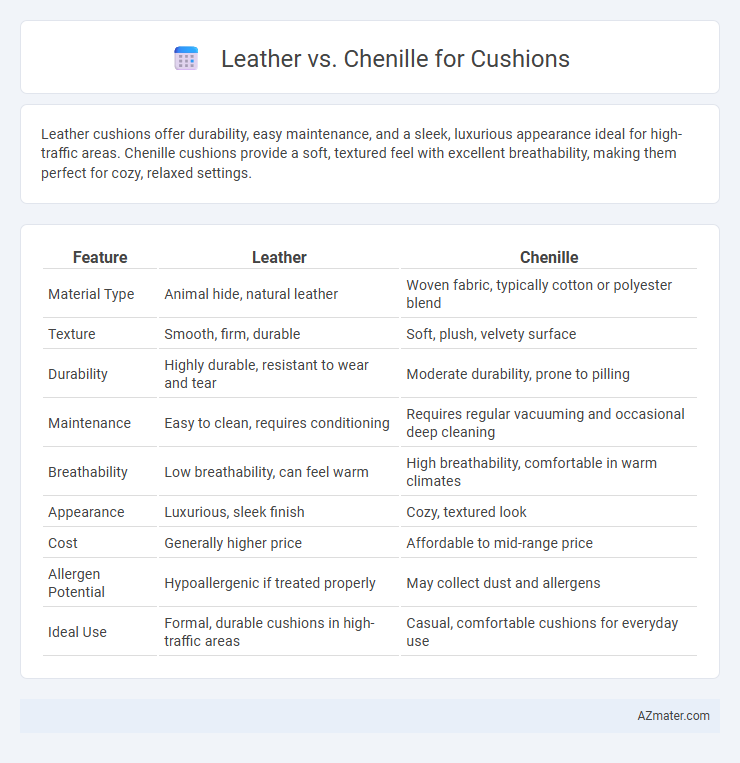Leather cushions offer durability, easy maintenance, and a sleek, luxurious appearance ideal for high-traffic areas. Chenille cushions provide a soft, textured feel with excellent breathability, making them perfect for cozy, relaxed settings.
Table of Comparison
| Feature | Leather | Chenille |
|---|---|---|
| Material Type | Animal hide, natural leather | Woven fabric, typically cotton or polyester blend |
| Texture | Smooth, firm, durable | Soft, plush, velvety surface |
| Durability | Highly durable, resistant to wear and tear | Moderate durability, prone to pilling |
| Maintenance | Easy to clean, requires conditioning | Requires regular vacuuming and occasional deep cleaning |
| Breathability | Low breathability, can feel warm | High breathability, comfortable in warm climates |
| Appearance | Luxurious, sleek finish | Cozy, textured look |
| Cost | Generally higher price | Affordable to mid-range price |
| Allergen Potential | Hypoallergenic if treated properly | May collect dust and allergens |
| Ideal Use | Formal, durable cushions in high-traffic areas | Casual, comfortable cushions for everyday use |
Introduction to Cushion Material Choices
Leather cushions offer durability, easy maintenance, and a luxurious texture suitable for high-traffic areas, while chenille cushions provide a soft, cozy feel with rich color and texture variations perfect for adding warmth to living spaces. Leather resists stains and aging, making it ideal for families or pets, whereas chenille, made from woven cotton or synthetic fibers, enhances comfort and visual appeal but may require more careful cleaning. Choosing between leather and chenille cushions depends on balancing factors like lifestyle, aesthetic preferences, and desired comfort levels.
What Is Leather? An Overview
Leather is a natural material derived from animal hides, primarily from cows, known for its durability, breathability, and luxurious texture. It undergoes tanning processes to enhance its strength and resistance to wear and tear, making it ideal for furniture cushions that require longevity and easy maintenance. The material's ability to develop a unique patina over time adds character and aesthetic value, distinguishing it from synthetic or fabric alternatives like chenille.
What Is Chenille? An Overview
Chenille is a soft, textured fabric made from cotton, wool, or synthetic fibers, characterized by its fuzzy, caterpillar-like yarns woven into a distinctive pile. Unlike leather, which is durable and smooth with a natural grain, chenille offers a plush, cozy feel ideal for cushions requiring warmth and comfort. Its versatility in color and pattern options makes chenille a popular choice for decorative cushions that enhance interior aesthetics with softness and style.
Comfort Comparison: Leather vs Chenille
Chenille cushions offer superior softness and breathability, providing a cozy, plush feel ideal for long seating periods, while leather cushions deliver a firm, smooth surface that cools quickly but may feel less inviting over time. Chenille's textured fibers trap heat gently, enhancing warmth and comfort, whereas leather's temperature sensitivity can lead to discomfort in extreme conditions. Choosing between leather and chenille depends on preference for softness and warmth versus durability and sleek aesthetics in cushion comfort.
Durability and Longevity
Leather cushions offer exceptional durability due to their natural resistance to wear, stains, and tearing, making them ideal for high-traffic areas and long-term use. Chenille fabric, while soft and comfortable, tends to show signs of wear faster, including pilling and fading, especially with frequent use or exposure to sunlight. Choosing leather over chenille significantly enhances the cushion's lifespan, maintaining both appearance and structural integrity over time.
Maintenance and Cleaning Requirements
Leather cushions require minimal maintenance, needing only occasional wiping with a damp cloth and conditioning every 6 to 12 months to prevent drying and cracking. Chenille cushions demand more frequent cleaning, including regular vacuuming to remove dust and professional cleaning or spot treatment to maintain the fabric's softness and prevent stains. Leather's smooth surface resists spills and stains better than chenille, which can absorb liquids and dirt, making leather more durable and easier to clean over time.
Style and Aesthetic Appeal
Leather cushions offer a sleek, sophisticated appearance with a polished surface that enhances modern and minimalist interiors, providing a timeless elegance resistant to wear and staining. Chenille cushions present a soft, textured aesthetic that adds warmth and coziness, available in a wide range of colors and patterns which complement traditional and eclectic decor styles. The tactile richness of chenille contrasts with the smooth durability of leather, allowing designers to choose based on the desired ambiance and visual impact.
Cost Factors and Affordability
Leather cushions generally demand a higher price due to the cost of animal hides, tanning processes, and durability, making them a long-term investment despite the initial expense. Chenille cushions offer a more budget-friendly option with lower material and manufacturing costs, appealing to consumers seeking affordable, soft, and textured upholstery. The maintenance expenses for leather can also add to the total cost, whereas chenille typically requires less specialized care, further affecting overall affordability.
Allergy Considerations
Leather cushions offer a hypoallergenic surface that resists dust mites, pet dander, and mold, making them suitable for allergy sufferers. Chenille fabric, while soft and comfortable, can trap allergens more easily and requires frequent cleaning to minimize irritants. Choosing leather can help maintain a cleaner environment for those sensitive to common allergens.
Which Cushion Material is Right for You?
Leather cushions offer durability, easy maintenance, and a sleek, sophisticated look ideal for high-traffic areas or modern decor. Chenille cushions provide a soft, textured comfort with vibrant patterns, perfect for cozy, casual settings where tactile appeal matters. Choosing between leather and chenille depends on your lifestyle needs, preferred aesthetic, and the balance between durability and comfort you seek.

Infographic: Leather vs Chenille for Cushion
 azmater.com
azmater.com